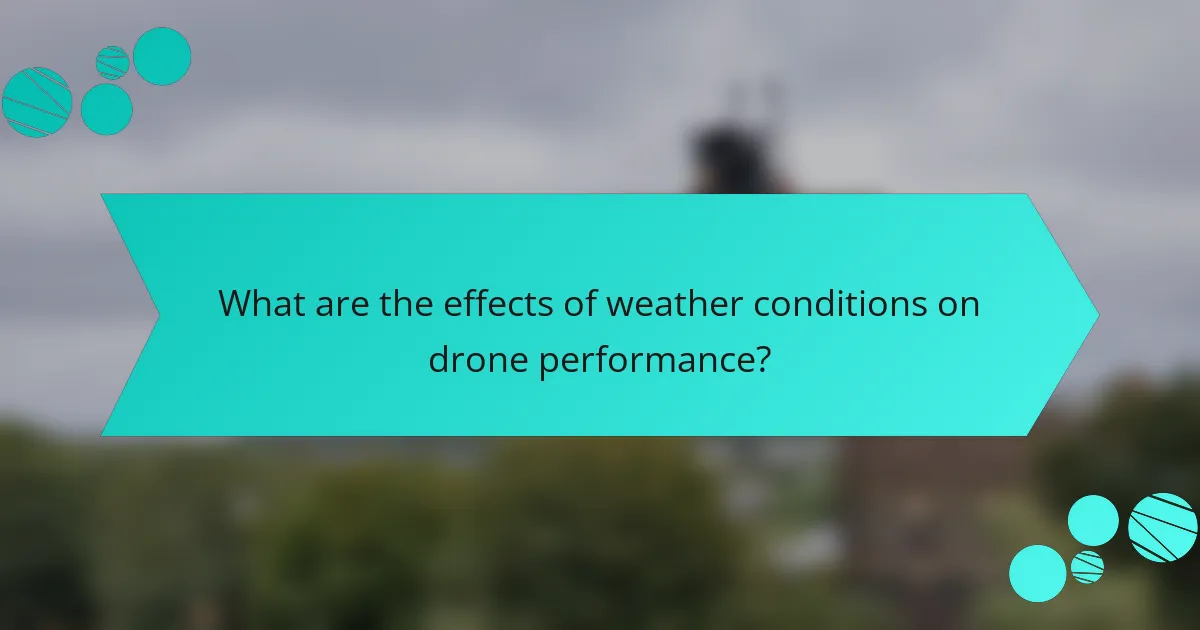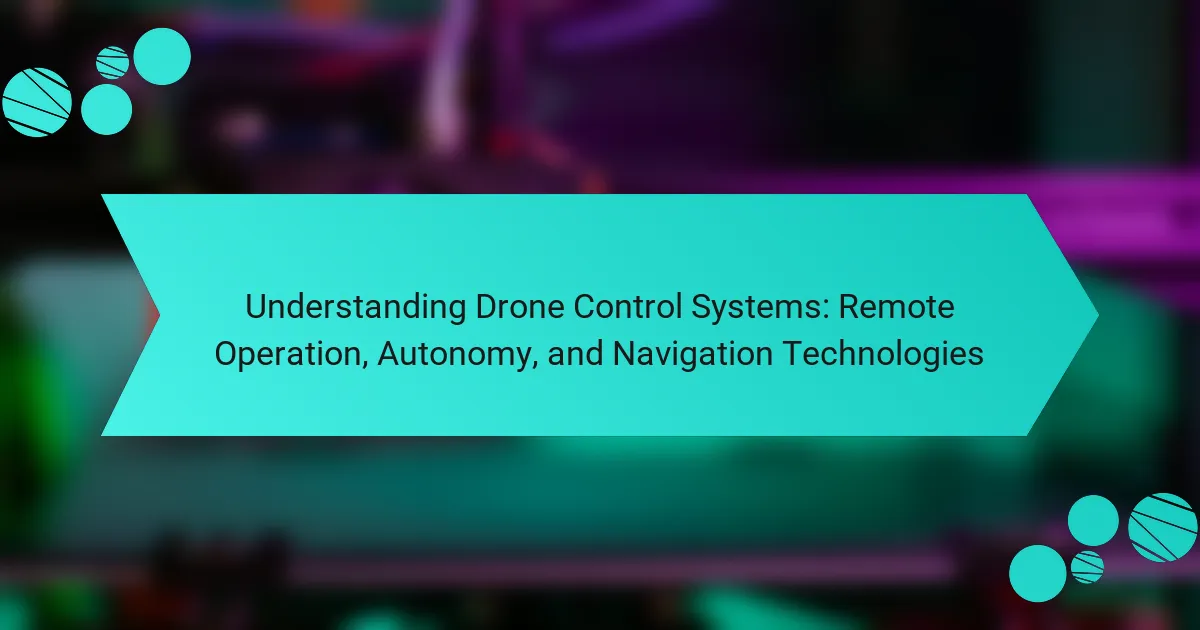
What are the effects of weather conditions on drone performance?
Weather conditions significantly affect drone performance. Wind can impact stability and control. High winds may cause drones to struggle with navigation. Rain can affect visibility and electronic components. Moisture may lead to malfunctions or reduced battery efficiency. Temperature extremes can influence battery life and motor performance. Cold weather may reduce flight time due to battery power loss. Hot weather can lead to overheating and reduced efficiency. These factors collectively determine a drone’s operational capabilities in various weather conditions.
How does wind impact drone stability and control?
Wind significantly impacts drone stability and control. High winds can cause drones to experience turbulence, making it difficult to maintain a steady flight path. Wind can lead to increased power consumption as drones work harder to counteract external forces.
Additionally, gusts can result in sudden altitude changes, affecting the pilot’s ability to manage the drone effectively. Research indicates that drones are more susceptible to lateral movement in windy conditions, which can lead to loss of control.
According to a study by the National Institute of Standards and Technology, drones operating in winds above 15 mph often struggle with stability and precision. This highlights the importance of assessing wind conditions before flight.
What wind speeds are considered safe for drone operation?
Wind speeds of up to 15 mph (24 km/h) are generally considered safe for drone operation. Drones can maintain stable flight and control under these conditions. At wind speeds exceeding 15 mph, performance may degrade. Many drone manufacturers recommend avoiding flights in winds above this threshold. For example, DJI states that their drones perform optimally in wind speeds below 15 mph. Additionally, individual drone models may have specific wind limits. Pilots should always consult the manufacturer’s guidelines for safe operation.
How do gusts affect flight performance?
Gusts negatively affect flight performance by causing sudden changes in airspeed and altitude. These rapid fluctuations can lead to instability during flight. Drones may experience difficulty in maintaining a steady course. This can result in increased workload for the pilot or automated systems. Gusts can also impact the lift generated by the drone’s wings or rotors. Research indicates that gusty conditions can lead to a 30% increase in fuel consumption. Additionally, drones may require more power to counteract the effects of gusts. This can reduce overall flight time and efficiency.
What role does rain play in drone functionality?
Rain negatively impacts drone functionality. It can cause water damage to electronic components. Drones are typically not waterproof, making them susceptible to malfunction. Reduced visibility occurs during rain, affecting navigation and obstacle detection. Rain also increases the weight of the drone due to water accumulation. This added weight can reduce flight efficiency and battery life. Furthermore, rain can disrupt the drone’s GPS signal, leading to navigation errors. Manufacturers often recommend avoiding drone operation in rainy conditions to ensure safe functionality.
How does moisture affect drone electronics?
Moisture negatively impacts drone electronics by causing short circuits and corrosion. When water enters electronic components, it disrupts electrical connections. This can lead to malfunction or complete failure of the drone. Corrosion can damage circuit boards over time, compromising performance. Moisture can also affect sensors and communication systems. For example, humidity can lead to inaccurate readings from altimeters and GPS. Additionally, moisture can create condensation inside the drone, further risking damage. High moisture levels can significantly reduce the lifespan of electronic components.
What precautions should be taken when flying in rain?
When flying in rain, pilots should ensure visibility and control. Use a drone with adequate water resistance. Monitor battery performance, as rain can affect power efficiency. Maintain a safe altitude to avoid obstacles and potential water damage. Avoid flying in heavy rain or thunderstorms due to increased risk of loss of control. Check local weather reports for updates. Ensure all sensors are functioning properly, as rain can obscure readings. Finally, be prepared for sudden changes in weather conditions.
How does temperature influence drone efficiency?
Temperature significantly influences drone efficiency. High temperatures can lead to reduced battery performance. Lithium polymer batteries, commonly used in drones, exhibit decreased capacity in extreme heat. This results in shorter flight times. Conversely, low temperatures can also affect battery chemistry. Cold conditions may cause batteries to drain faster and reduce overall power output.
Additionally, temperature affects the drone’s motor efficiency. Motors may overheat in high temperatures, leading to potential failure. In cold weather, lubricants can thicken, impacting motor performance.
Aerodynamics are also influenced by temperature. Warm air is less dense, which can decrease lift and require more power. Conversely, cold air is denser, which can improve lift but may increase drag.
Overall, temperature plays a crucial role in determining how efficiently a drone can operate.
What are the optimal temperature ranges for drone operation?
The optimal temperature range for drone operation is typically between 0°C to 40°C (32°F to 104°F). Drones can experience performance issues outside this range. Below 0°C, battery efficiency decreases significantly. Cold temperatures can lead to reduced flight times and potential malfunction. Above 40°C, overheating may occur, affecting the drone’s electronics. High temperatures can also cause battery degradation. Manufacturers often specify these temperature limits in user manuals. Adhering to these guidelines ensures optimal performance and safety during flights.
How does extreme cold or heat affect battery life?
Extreme cold and heat significantly affect battery life. Cold temperatures can reduce a battery’s capacity and efficiency. Lithium-ion batteries, commonly used in drones, may lose up to 20% of their capacity at freezing temperatures. This results in shorter flight times. Conversely, high temperatures can lead to increased internal resistance. Excessive heat can cause batteries to degrade faster, potentially reducing their lifespan. High temperatures may also trigger thermal runaway, a dangerous condition that can damage the battery. Thus, both extreme cold and heat adversely impact battery performance and longevity.
What are the combined effects of wind, rain, and temperature on drone performance?
Wind, rain, and temperature significantly impact drone performance. High wind speeds can cause instability, leading to difficulty in control and navigation. Rain can reduce visibility and affect electronic components, potentially leading to malfunctions. Extreme temperatures can impact battery life and overall drone efficiency. Research indicates that drones may experience reduced flight times in cold weather due to battery capacity loss. Additionally, optimal operating temperatures for many drones are typically between 20°C to 30°C. These weather conditions can collectively hinder a drone’s ability to perform as intended.
How can pilots adapt to variable weather conditions during flight?
Pilots can adapt to variable weather conditions during flight by utilizing real-time weather data and adjusting their flight paths accordingly. They monitor meteorological updates through onboard systems and air traffic control. This enables them to identify turbulence, storms, and wind patterns. Adjusting altitude can help pilots avoid adverse weather effects. They also employ specific flight techniques, such as reducing speed in turbulent areas. Additionally, pilots are trained to handle various weather scenarios, enhancing their decision-making skills. Research indicates that proactive weather management improves flight safety and efficiency. Studies show that pilots who anticipate weather changes can reduce the risk of incidents.
What strategies can be employed to ensure safe drone operation in adverse weather?
To ensure safe drone operation in adverse weather, operators should implement several key strategies. First, they must conduct thorough pre-flight weather assessments. This involves checking real-time weather data, including wind speed, precipitation, and temperature. Second, operators should establish strict operational limits based on weather conditions. For instance, flying in winds exceeding manufacturer recommendations can lead to loss of control. Third, using drones equipped with advanced sensors can improve safety. These sensors can provide real-time feedback on environmental conditions. Fourth, operators should have clear emergency protocols in place. This includes predefined procedures for landing in adverse conditions. Lastly, ongoing training for pilots is essential. Regular training helps them make informed decisions during unpredictable weather events. These strategies collectively enhance the safety of drone operations in challenging weather.
What best practices should drone operators follow to mitigate weather-related risks?
Drone operators should conduct thorough weather assessments before flights. They must check real-time weather data and forecasts. Monitoring wind speed and direction is crucial. Operators should avoid flying in high winds, heavy rain, or extreme temperatures. Using weather apps or services can provide accurate updates. Additionally, operators should plan alternative routes or reschedule flights if conditions are unfavorable. Pre-flight checks should include verifying the drone’s specifications against weather conditions. Understanding the drone’s limits enhances safety during adverse weather. These practices help ensure safe and effective drone operation.
The main entity of this article is drone performance, specifically how it is influenced by weather conditions such as wind, rain, and temperature. The article provides a detailed analysis of how wind affects stability and control, the impact of rain on visibility and electronic components, and the role of temperature in battery efficiency and overall operational capabilities. It also outlines safe operating conditions, best practices for pilots, and strategies to mitigate risks associated with adverse weather. Key findings include recommended wind speeds for safe operation, optimal temperature ranges, and the combined effects of various weather elements on drone functionality.



